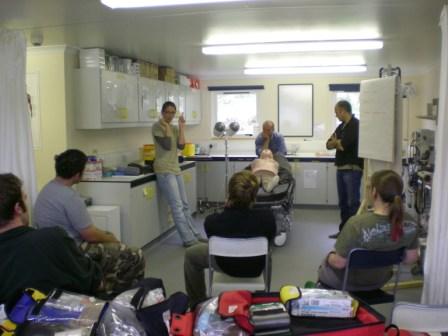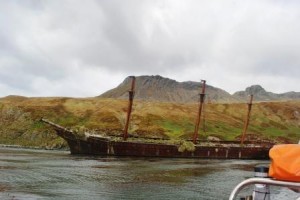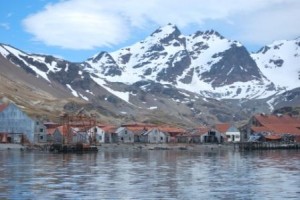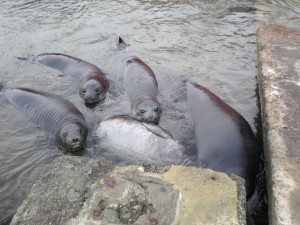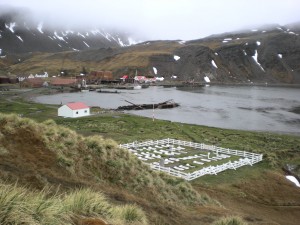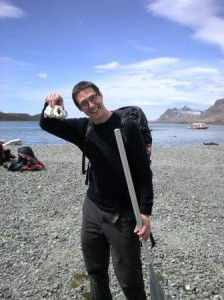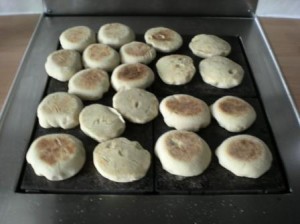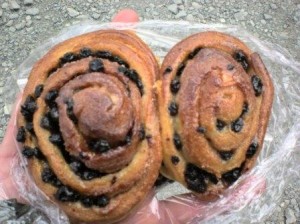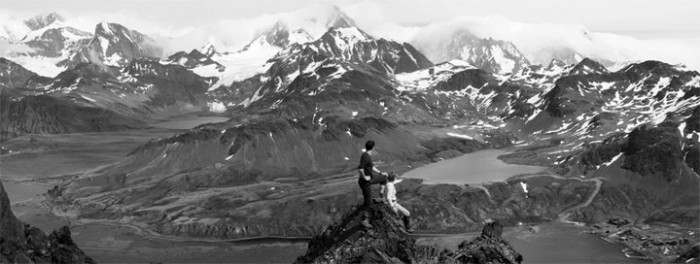South Georgia
Doc School
Every monday at 4pm we have doc school run by our Dr on base Sam. We are our own Search and Rescue team and also our own paramedics and the Dr is only one person so she needs help in the case of a major problem. This picture is taken in the surgery on base which is very well set up with an anastesis machine and xray machine. This week was trauma next week will be anaphalaxis.
Invasion of South Georgia
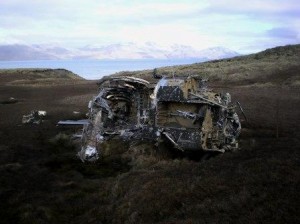
In the evenings after work and before dinner I try to go for a walk sometimes I make it over to the Argentine Puma helicopter remains on the lower slopes of Brown Mountain across from base.
Below is the information from wikipedia…
The Puma landed a first group of 15 Argentine marines on King Edward point at 11:41 AM, on the opposite side from Shackleton House, where the Royal Marines were entrenched. By then, the Guerrico knew that the general area of deployment of the Royal Marines was on the northern shore of the cove’s mouth. The second wave of marines took off from Bahia Paraiso deck on board the Puma at 11:47. The commander of the Argentine group already inland, Lt Luna, requested via the Guerrico—he had no direct communication with Bahia Paraiso—that the second wave should be equipped with 60 mm mortars, but the party was already in flight. The landing was to take place to the east of Luna’s position, well within the view of the British detachment.[23] The helicopter was spotted by Mills and his men and met by intense automatic fire. The pilot was able to cross the bay and crash-landed the helicopter on the southern bank of the bay. Two men were killed and four wounded. At the same time, Luna’s troops started their march towards Shackleton House, but the marines pinned them down with heavy gunfire.[5] Therefore, Luna asked the Guerrico for fire support.
Bayard
Last week we went down the north coast to take one of the government officers and Kelvin (spraying an invasive grass species) on a jet boat and a RIB.
This is a picture of the Bayard a wreck in Ocean Harbour a three masted, 1028 ton, 67 m (220 ft) long, iron hulled sailing ship. She was built in 1864 by T. Vernon and Son, Liverpool for the Hall Line . In 1868 she was transferred to Sun Shipping Company and in 1881 sold to Foley and Company.On 20 August 1883 she arrived in Suva, Fiji carrying 494 Indian indentured labourers from Calcutta. She had previously carried indentured labourers to the West Indies.
In 6 May 1885, Bayard hit an iceberg, 55 miles South of Cape Race while on a voyage from Marseilles to St. Pierre. The ship lost her stern, bowsprit, jib boom, foremast, topgallantmast and yard, but reached her destination on 23 May, leaking badly.
She was moored at the coaling ship at Ocean Harbour but during a severe gale in June 1911, she blew off her mooring and ran aground. They tried to no avail to pull her off the rocks. There are now about 80 breeding pairs of blue eyed shags nesting on the wreck.
The bay is a deeply indented and the mountains on each side come right to the water. During a survey of the island in 1951-52, the South Georgia Survey reported that whalers and sealers called the cove Ocean Harbour, derived from the Ocean Whaling Co. which had a active whaling station there between 1909 and 1920.

The cemetry at Ocean Harbour has only a few crosses left. The marker on the oldest known grave of the island – that of Frank Cabrail (1820) of the sealer Francis Allen no longer exists. There was one cross with a relatively new looking plaque on it from 1920 (see picture).
Stromness
This is a picture of Stromness whaling station which we went to this week. Stromness operated as a whaling station from 1912 until 1931. In 1931 it was converted into a ship repair yard with a machine shop and a foundry. It remained operational until 1961 when the site was abandoned.
In 1916, Ernest Shackleton and a small crew landed on the unpopulated southern coast of South Georgia at King Haakon Bay after an arduous sea voyage from Elephant Island in the 22-foot lifeboat James Caird. Shackleton along with Tom Crean and Frank Worsley then trekked across South Georgia’s mountainous and glaciated interior in an effort to reach help on the populated northern shore of the island. After 36 hours of crossing the interior they arrived at the Stromness administration center which also was the home of the Norwegian whaling station’s manager. This building has been dubbed the “Villa at Stromness” because it represents relative luxury compared to its surroundings. All men were rescued from Elephant Island.
Weener Creche…
This is a picture of the elephant seal pups or weeners as we call them. They are in the shallow water between the wharf and the slipway it is where they ‘learn’ to swim. There are a lot of them on the beaches around base at the moment. Much cuter than the fur seals which come out of their mothers full of piss and vinegar ready to have a go at you.
Shackleton’s grave
This is a picture of the cementry at Grytviken which is where Shackleton lies. His is the only grave in the cemetry that points north/south instead of east/west. He was buried on 5 March 1922 after a short service in the Lutheran church nearby. Next Friday we are going to have a dance in the church a celebration for Tee’s birthday. He owns Wanderer III a 30 footer which has wintered over here for the last two years with his wife Kiki. The photos was taken from cementry gully which is a waterfall just behind the graveyard – a beautiful spot to watch the world go by at the beach and a good way to get up to Gull Lake in the evenings.
Rob Webster
This is Rob he is the base commander at KEP. He spent 2.5 years at Rothera as a met observer and after a year and bit back at home he decided to head south again. A talented musician and also woodworker – he actually made his own guitar at Rothera.
Husvik
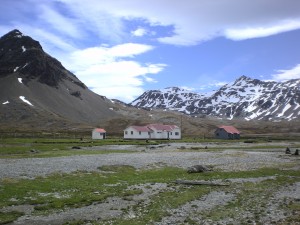
On tuesday we took the government officer and Kelvin (who is here from NZ spraying invasive plants) to Husvik one of the old whaling stations 15 miles up the coast from base. It was a stunning day and while they were ashore for 4 hours we went and had a closer look at Stromness and Leith another two stations close by.
Since the below was written there is no access to the villa. We did encounter the fur seals and use of our bodgers (wooden stick) was necessary as they did try to charge us. At the cemetry we put the chain fence back together to the best of our ability.
Below is an extract about the station from wikipedia…
Husvik is a former whaling station on the north-central coast of South Georgia Island. It was one of three such stations in Stromness Bay, the other two being Stromness and Leith Harbour. Husvik initially began as a floating, offshore factory site in 1907. In 1910, a land station was constructed and remained operational until 1930; business resumed again between 1945 and 1960.
The three whaling stations, Husvik, Stromness and Leith were linked by a rough track along the beach. During the whaling era, whalers from Stromness and Husvik would use it to get to Leith Harbour to use the cinema. The track can still be still used, but in some places is rendered impassable by aggressively territorial fur seals during their breeding season (November and December).
The freezer plant was dismantled and moved to Grytviken in 1960, and whaling operations at Husvik permanently ceased. Afterwards, scientists from the British Antarctic Survey used the whaling managers’ villa as a temporary shelter when doing work in the area up until the mid 1990s. More recent inhabitants include the BSES expedition of December 2003, who used it as a base camp for a number of scientific and exploratory projects.
As with Leith, Stromness, and Prince Olav Harbour, the whaling station has been declared by the South Georgia Government as being too dangerous to visit, due to the danger from collapsing buildings and asbestos. Visitors must stay 200 m (656 ft) from the buildings and structures. Access to the villa is permitted as it is away from the main station area.
The jetty is within the 200 m (656 ft) ‘danger area’ so is not usable, and is in a very dilapidated state. A colony of Blue-eyed shags nests on its end each year.
In the southern summer of 2005/6, the South Georgia Heritage Trust hired a team of Norwegian craftsmen to restore some of the buildings at Husvik. In March 2006, the Manager’s Villa, a building known as the “Radio Shack” and a small generator shed were successfully repaired and restored.
South of Husvik is a whaler’s cemetery where 34 men were buried between 1924 and 1959.
Sunday muffins
Every morning at 6am on a rota system someone makes bread dough and leaves it to rise in the electrical cupboard (warm) to rise while they go and do the morning rounds around base. We make all the bread that is eaten on station and as it is so good it is hard not to eat a lot of it especially when it comes out of the oven all warm. Now and again it is fun to make a different type then just the normal loaves. So on Sunday I made english muffins which to my surprise turned out OK. As you can see they are cooked right on the top of the stove.
The weekend before I made chelsea buns.
Recreating the Hurley photo
On Sunday Rob, Alastair and I climbed up Mount Duse which is just above station with camera and tripod to recreate a photo taken by Hurley in 1915. The result you can see below. We had tried with a different group a few weekends before but didn’t realise that it was actually two plates put together until we read a book on station about Hurley and the Trans Antarctic photos that he took. It was a beautiful day for the small climb – just glad we didn’t have a large camera in tow like they did 95 years ago!
Thanks Alastair for doing a great job with stitching the two photos together after taking them!


